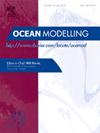A global high-resolution CMIP6 ensemble of wave climate simulations and projections using a coastal multigrid: Configuration and performance evaluation
IF 2.9
3区 地球科学
Q2 METEOROLOGY & ATMOSPHERIC SCIENCES
引用次数: 0
Abstract
This study presents a comprehensive evaluation of a high-resolution wave climate ensemble, driven by eight CMIP6 General Circulation Models (GCMs), using a coastal multigrid approach based on Spherical Multiple-Cell (SMC) grid. The use of the SMC grid allows for global wave climate simulations refined to high resolutions up to 6 km in coastal regions, where complex interactions between wind, waves, and bathymetry demand more precise modelling. The ensemble’s performance is assessed against wave reanalysis datasets and near-coastal in-situ wave observations, with a focus on key wave climate parameters: significant wave height, mean wave period, peak wave period, and mean wave direction. Results show that the ensemble is able to accurately represent the historical wave climate across diverse regions, excelling in coastal areas, when compared with previous similar datasets, namely across Europe, North America and the Maritime Continent. The multi-resolution SMC grid captures complicated coastal wave patterns and improves the representation of coastal wave dynamics. The ensemble’s ability to simulate both seasonal variability and extreme wave events highlights its potential for high-resolution global wave climate projections, with multiple applications for coastal management and adaptation strategies, marking an advancement in wave climate modelling through its integration in high-resolution, multigrid frameworks.
基于沿海多重网格的全球高分辨率CMIP6海浪气候模拟和预估:配置和性能评估
本文利用基于球面多单元格网(SMC)的沿海多网格方法,对8个CMIP6环流模式(GCMs)驱动的高分辨率波浪气候集合进行了综合评价。SMC网格的使用允许在沿海地区将全球波浪气候模拟精细到高达6公里的高分辨率,在这些地区,风、波和水深测量之间的复杂相互作用需要更精确的建模。根据波浪再分析数据集和近岸现场波浪观测对该系统的性能进行了评估,重点关注了关键的波浪气候参数:有效波高、平均波周期、峰值波周期和平均波方向。结果表明,与以往的类似数据集(即欧洲、北美和海洋大陆)相比,该集合能够准确地代表不同地区的历史波浪气候,在沿海地区表现出色。多分辨率SMC网格捕捉了复杂的海岸波型,改善了海岸波动力学的表征。该集合模拟季节变化和极端波浪事件的能力突出了其在高分辨率全球波浪气候预测方面的潜力,在沿海管理和适应策略方面具有多种应用,通过集成高分辨率、多网格框架,标志着波浪气候建模的进步。
本文章由计算机程序翻译,如有差异,请以英文原文为准。
求助全文
约1分钟内获得全文
求助全文
来源期刊

Ocean Modelling
地学-海洋学
CiteScore
5.50
自引率
9.40%
发文量
86
审稿时长
19.6 weeks
期刊介绍:
The main objective of Ocean Modelling is to provide rapid communication between those interested in ocean modelling, whether through direct observation, or through analytical, numerical or laboratory models, and including interactions between physical and biogeochemical or biological phenomena. Because of the intimate links between ocean and atmosphere, involvement of scientists interested in influences of either medium on the other is welcome. The journal has a wide scope and includes ocean-atmosphere interaction in various forms as well as pure ocean results. In addition to primary peer-reviewed papers, the journal provides review papers, preliminary communications, and discussions.
 求助内容:
求助内容: 应助结果提醒方式:
应助结果提醒方式:


